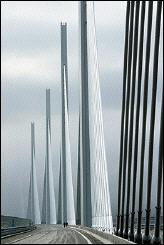
Biggest Bridge in the World

MILLAU, France (AFP) - As air force jets screamed overhead, French President Jacques Chirac inaugurated the world's tallest bridge, a stunning masterpiece of engineering that will carry drivers 270 metres (885 feet) above ground.
He spoke of the viaduct, whose highest point soars to 343 metres -- higher than the Eiffel Tower in Paris -- over the river Tarn in southern France, as a monument to French daring and enterprise.
Built to schedule in three years, it was commissioned in order to open up a new north-south route and ease pressure on one of the nation's most notorious motorway bottlenecks.
Before an audience of around 1,000 people, including the viaduct's British architect Norman Foster, Chirac unveiled a plaque by the largest of its seven pillars.
"The Millau viaduct takes its place among our most shining works of civil engineering. It brilliantly embodies the verve of our research and technology," he said.
"The French people are rightly proud of the feats accomplished here -- feats which speak for France. A modern France; an enterprising, successful France; a France which invests in its future."
The bridge, stretching 2.46 kilometres (1.6 miles) between two plateaux in the Massif Central mountain range, opens to traffic Thursday, easing pressure on the saturated Rhone valley to the east, used by lorry drivers and tourists bound for the Mediterranean and Spain.
Like a taut thread pierced by a line of needles, the silhouette dominates the countryside for miles around and has been praised as a classic marriage of aesthetics and science.
"A work of man must fuse with nature. The pillars had to look almost organic, like they had grown from the earth," said Foster, whose other works include the renovation of the Reichstag in Berlin and Chek Lap Kok airport in Hong Kong.
"The bridge could not look as if it had been tacked onto the scenery. It had to rise out of the landscape with the delicacy of a butterfly."
The viaduct is not only the world's tallest -- outstripping the 282-metre towers of Japan's Akashi Kaikyo bridge -- but is also the longest multi-span cable-stayed bridge.
The Tatara Ohashi bridge, also in Japan, is 1.48 kilometres long.
The highest bridge in the world -- measured by distance from ground to deck -- remains the Royal Gorge Bridge in Colorado, United States, at 320 metres above the river Arkansas.
Unusually for such a large infrastructure project in France, its 390 million euro (520 million dollar) cost was financed entirely by the private sector, with the construction giant Eiffage getting the right to collect tolls for 75 years in return.
Until now, drivers on the A75 motorway between Clermont-Ferrand and Beziers have been forced to a crawl as they descended to the town of Millau.
Now they will have to pay a fee of 4.9 euros (6.5 dollars) to speed above the town, while truckers will be charged about four times as much.
Eiffage is predicting an average of 10,000 vehicles per day, with a peak of 25,000 during the summer season when tariffs will be increased.
If the bridge proves unexpectedly profitable, the French state has the right to take possession from 2044.
Weighing some 36,000 tonnes, the bridge was assembled as much as possible off-site. Large sections were lifted by giant crane and slid onto the pillars, with the two ends meeting in May.
It has been built to withstand wind-speeds of up to 250 kilometres per hour.
"In our civilisation infrastructure is fundamental. Public spaces, avenues, bridges over rivers -- these are what bring men together and condition our quality of life. But there are also needs which one cannot measure, which are more spiritual," Foster said.
"Ideally passing over the bridge should allow one to 'elevate oneself'," he added.
"Looking at it should provoke an emotion. Its purpose is to allow people to cross the valley without damaging the town of Millau. But it goes far beyond that."
It has been good for Eiffage too. Last week, its shares were trading at 83 euros, a record high and up 137 percent since 2001.